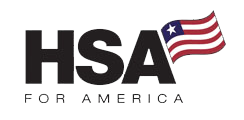
Under current law, those who choose health sharing over traditional health insurance products have been excluded from enjoying the powerful tax advantages of HSA contributions. This is because the law requires anyone who contributes to be enrolled in a qualified high deductible health plan that provides certain minimum essential coverages (MEC).
And since health sharing plans are not insurance policies, they don’t qualify.
As a result, most health share members have had to choose: Enroll in a health sharing plan for the significant cost savings compared to a traditional Obamacare Marketplace-style insurance product, or pay extra for a special HSA-eligible health insurance product.
But thanks to a new solution, HSA MEC, available through HSA for America, it’s now possible to ‘soup up’ any health sharing plan to be HSA eligible.
How?
Simply by enrolling in HSA MEC, alongside your health sharing plan.
Note: As of 2024, HSA MEC is only available to business owners, independent contractors, or those with verifiable self-employment income.
Understanding Health Sharing Plans and HSAs
Health sharing plans, offering a cooperative approach to healthcare costs, have evolved into a mainstream solution.
Paired with HSAs, tax-advantaged accounts designed for individuals with High Deductible Health Plans (HDHPs), they present a new frontier in healthcare management.
Compare Pricing on the Best Insurance Plans Available
Become HSA-Eligible With HSA MEC
HSA MEC is a revolutionary Minimum Essential Coverage plan that is now available as a standalone product.
It’s a specially-designed limited benefit MEC plan, carefully tailored to meet the Affordable Care Act’s minimum requirements to qualify as a high-deductible health plan.
What is a Limited Value MEC Plan?
The HSA MEC is designed to cover only the basics required by the Affordable Care Act (ACA).It includes all the preventive services required under the Affordable Care Act with $0 out-of-pocket costs, but offers limited benefits beyond that. This means it will cover checkups, immunizations,
What defines a High-Deductible Health Plan (HDHP)?
An HDHP is characterized by higher deductibles and lower premiums compared to standard health insurance offerings available through the ACA marketplace.
For 2024, the minimum deductible HDHP deductible is $1,600 for individual coverage and $3,200 for family coverage.
Because HSA MEC is designed to meet the technical requirements to qualify as an HDHP, and it offers the bare minimum set of essential benefits to qualify as a MEC, HSA MEC plan members are eligible to make tax-free contributions to a health savings account – provided they meet the other eligibility criteria below. Note that the deductible does not apply to the preventive benefits.
Health Savings Account Rules
Are You Eligible for An HSA?
To be eligible to make pre-tax contributions to a health savings account, you must meet these criteria.
- You must be enrolled in a qualified high-deductible health plan (HDHP). As of 2024, the minimum allowable deductible for an HDHP is $1,600 for self-only plans, and $3,200 for family plans.
The HSA MEC plan meets this requirement. - You cannot be enrolled in other coverage such as Medicare, Medicaid, TRICARE, or TRICARE For Life.
- You cannot be enrolled in a spouse’s health insurance plan (unless that plan is HSA-eligible).
- You must not have used VA medical benefits within the last three months.
Exception: Veterans with service-connected disabilities or who have only accessed disregarded coverage and preventative services over the prior three months may contribute to an HSA if they are enrolled in an HDHP.
- You cannot be claimed as a dependent on someone else’s tax return
- You aren’t enrolled in an employer’s health reimbursement arrangement (HRA), flexible spending account (FSA) or other disqualifying health plan alternative.
And because HSA MEC is a stand-alone product, you can mix-and-match it with any health sharing plan HSA for America offers – with the exception of HSA SECURE, because HSA SECURE has a similar plan already built into the product.
Portability: Your HSA Funds Are Yours to Keep
One of the greatest advantages of a Health Savings Account (HSA) is the peace of mind that comes with its flexibility. Unlike some financial vehicles, such as flexible savings accounts, HSAs are not subject to a “use-it-or-lose-it” policy.
- Permanent Ownership. The funds in your HSA remain with you, regardless of changes in your employment status or healthcare coverage.
- Contributions Stay With You. Whether contributions to your HSA come from you, your employer, or any other source, they’re yours to use at any time you need them.
- HSAs are a Long-Term Strategic Asset. Your HSA potentially stays with you long after you change jobs or health plans, and well into retirement. You can even potentially pass on your HSA to loved ones after you die.
And you can use your HSA to pay healthcare expenses tax free and even supplement your income in retirement, penalty-free.
The enduring nature of HSAs ensures that your healthcare savings are a long-term asset, ready for you whenever healthcare needs arise, and more.
| Benefits of Health Sharing | Benefits of HSAs |
|---|---|
| Costs savings: Up to 50% less than unsubsidized traditional insurance premiums | Contributions are tax-free |
| Choose your own doctor | No income limits on eleigibity |
| No narrow network restrictions as with HMOs | Tax-deferred growth |
| non-profit mutual aid association rather than for-profit insurance company | Tax-free withdrawals for qualified medical expenses |
| Like-mided community of fellow members | No RMD requirements |
| Doesn't cover many services you don't want or need | Withdrawals after age 65 are penalty-free |
| Shares major and catastrophic medical expenses | HSA distributions after age 65 are taxed ordinary income, like traditional IRAs |
| Discounts on drugs, labs, images, and other medical goods and services | Pay for medical expenses with tax-free dollars |
| Provides cash to pay expenses medical insurance or healthcare plans don't cover or share | |
| Can be used to help pay transportation costs, medications, modifications to vehicles and homes |
Combining Health Sharing and HSAs
HSAs are not just savings accounts; they are strategic financial tools that offer flexibility and control over healthcare spending.
For many, HSAs serve as a critical component of their overall financial planning, offering a way to save and invest for future healthcare needs while providing immediate tax benefits.
The combination of a low-cost health-sharing plan with our HSA MEC provides a broad spectrum of important benefits:
Your health sharing plan provides access to massive capacity for sharing catastrophic or potentially bankrupting or life-changing medical costs like surgeries and long hospitalizations.
Your HSA, on the other hand, can help you effectively save up to 30 to 35 percent on smaller medical expenses, such as health insurance deductibles or, if you are a health sharing member, your member responsibility amounts, co-pays, transportation costs, prescription drug costs, and other amounts that aren’t shareable under your health sharing account.
Provided you meet the other qualifications to contribute to an HSA detailed in IRS Publication 949, enrolling in HSA MEC counts as an HDHP. You are therefore qualified to make pre-tax qualifications to your HSA.
Who Needs HSA MEC and Health Sharing?
Lots of people!
Especially those who don’t get a subsidized group plan from an employer, who don’t get a subsidy for an Obamacare Plan, and who are in relatively good health with no major pre-existing conditions.
For example:
Consider the case of a freelance graphic designer who, without access to employer-provided health insurance, opts for a Health Sharing Plan. By adding HSA MEC, they can now set aside money in an HSA, reducing their taxable income and building a reserve for future medical expenses.
Similarly, a small business owner, struggling with the rising costs of traditional health insurance for their employees, finds a viable alternative in combining a health sharing plan with an HSA. This combination not only lowers their monthly healthcare costs but also provides a tax-efficient way to save for medical expenses.
HSA MEC Costs vs. Benefits
The financial analysis reveals that maximizing HSA contributions leads to significant tax savings, often surpassing the premiums for HSA MEC.
The benefit is particularly significant if you’re in a higher tax bracket, or you have few other deductions.
Here’s how it works:
Let’s assume you file a joint return, and you’re currently in the 33% marginal tax bracket. You earn too much to receive a health insurance subsidy.
So by enrolling in a health sharing plan rather than paying full price for a bloated, inefficient traditional health insurance product, you are already saving 50% compared to the monthly cost of health insurance premiums.
With traditional health insurance now averaging nearly $2,000 per month for a family, according to data from the Kaiser Family Foundation, those savings can amount to as much as $12,000 per year.
That’s enough cash flow to fully fund a health savings account to begin with… if you were eligible to contribute to one.
So the next step is to become eligible.
That’s where enrolling in HSA MEC comes in. Once you sign up, you’re eligible to contribute to your HSA.
However, while HSA MEC has some great preventive care and other benefits, it costs something to enroll.
Depending on your age and other circumstances, your monthly premium may amount to about $85 to $160 per month, or $1020 to $1920 per year.
But by adding HSA MEC to your health plan, you now qualify to contribute up to $8,300 to your HSA.
That means you can reduce your taxable income by that same amount by contributing the maximum to your HSA.
If you are in a 33% average tax bracket, that means you would realize $2,700.67 in federal tax savings in the current year.
At year end, when you file your taxes, your net tax benefit is $2,700.67 – $1020 to $1920 per year.
Savings: $780 to $1,680!
That’s a pretty good 12-month ROI.
If you are over 55, you could save an additional $333.33, thanks to the additional “catch-up” contributions.
If both you and your spouse are over 55, you can save an additional $666.67.
That’s just in the first year.
That doesn’t even account for the beneficial effects of tax-deferred compounding over years. And it doesn’t include the potential benefits of paying qualified medical expenses and long-term care insurance premiums with tax-free dollars.
The HSA Jump Start Guide: How To Open an HSA and Make Your First Contribution
Once you know you’re eligible to make new HSA contributions, here’s a step-by-step guide to actually getting started with your health savings account.
1. Choose an HSA Custodian
If you enroll in HSA MEC, you’ll automatically have an account opened for you with Optum Bank, an established and well-respected HSA custodian firm.
An HSA custodian is a financial institution that holds and manages the funds in your HSA. They ensure your account complies with IRS regulations, provide you with account statements, and in some cases may offer some alternative investment options for your HSA funds.
However, as your account balance and needs evolve, it’s possible that you’ll want to change your HSA custodian to a different firm that may offer more benefits, more investment options, and/or lower fees.
Here’s what makes for a good HSA custodian:
- Low fees. Any fees an HSA custodian charges comes straight out of your HSA investment returns.
- Liquidity. You want it to be easy to access your HSA at any time, with very low or no fees to take a distribution.
Investment options. The best HSA custodians support self-directed HSA investing. They provide a menu of low-cost options allowing you to invest in a variety of asset classes, so that you can invest your long-term HSA savings into something with potentially greater returns than cash or cash equivalents.
Examples of other asset classes that might work well for your HSA include:
- Stocks
- Bonds/fixed income
- International investments
- Guaranteed investment contracts (GICs
- Money market funds
- Treasuries
- ETFs
Customer service. Quality customer service is a big plus. You want short wait-times on calls, and prompt response times when communicating by email or text.
2. Complete the Application
If you are enrolling in HSA MEC, you’ll automatically have an account opened for you at Optum Bank as part of your enrollment process.
You will need the following information:
- Your Social Security Number
- A valid e-mail address
- If enrolling as part of an employer group, you’ll need your Medical ID card containing your Group/Employer number.
You may also need the following:
- A copy of your Social Security card.
- A copy of a valid photo identification card with your address. (A driver’s license, passport, state- or government-issued photo ID will suffice.)
- A copy of a utility bill, renter’s agreement, or mortgage statement with your name and address (if your ID does not contain your address. A cell phone bill is not acceptable for address verification purposes.
3. Fund Your HSA
Once your account is established with your custodian, the next step is to transfer money into the account.
You can do this online via ACH transfer, which is the safest and most secure, or by check.
There may be a minimum initial deposit requirement, depending on your custodian. With Optum Bank, the HSA MEC default custodian, the minimum transfer amount is $100.
Tip: If you can, try to contribute the maximum allowable amount to your health savings account every year. The tax benefits are just too good to pass up!
HSA Contribution Limits: How Much Can I Contribute?
It depends on whether you are funding an HSA for yourself, only, or for your spouse and family as well.
- Self-only plan contribution limit: $4,150
- Family plan contribution limit: $8,300
Those age 55 or older can make additional “catch-up”: contributions of up to $1,000 per year. If your spouse is also 55 or older, they have the option to open their own HSA and take advantage of this catch-up contribution,
This pushes your maximum allowable combined contribution up to $10,300.
Q. Are there any income limitations, thresholds, or phaseouts to HSA contribution eligibility?
No. If you’re eligible, you can contribute the maximum to your HSA regardless of your income.
Q. When is the HSA contribution deadline?
You have until the tax filing deadline, typically April 15, to add funds to your HSA for the preceding year.
However, once you are on Medicare, you are no longer eligible for new contributions for that period.
4. Decide How You Want Your HSA Assets Invested
The HSA MEC plan’s custodian, Optum Bank, supports self-directed investing.
This allows you to choose to invest some or all of your HSA into a variety of asset classes other than cash.
This is a major advantage because it allows you to potentially get much greater growth in your HSA over time. However, you can also potentially lose money in these investments.
HSA MEC investment options
Once your HSA assets held with our default custodian Optum Bank exceeds $2,100, you have the option to invest your HSA assets in a variety of mutual funds with Vanguard.
This much-venerated investment company is known for providing a wide variety of investment options with rock-bottom fees – especially its index funds.
You can mix-and-match mutual fund allocations yourself, according to your own investment timeline, medical needs, and tolerance for risk.
You can also invest your HSA assets in “target date” mutual funds. With these funds, you pick a “retirement date,” and professional investment managers at Vanguard will select your investments for you.
As your projected retirement date gets closer, Vanguard will gradually roll back your risk exposure and focus more on safer, less volatile investments.
At any point, you can log onto your HSA MEC/Optum Bank portal and transfer funds, reallocate balances between mutual funds, or set up automatic rebalancing.
If you have a need for cash to pay a qualified medical expense, it’s easy to transfer assets from mutual funds back to your HSA cash account to pay for it via your HSA debit card.
Step 5: Use Your Special HSA Debit Card for Qualified Medical Expenses
When you enroll in HSA MEC, keep a lookout for your special HSA debit card from Optum Bank to arrive in the mail.
If you have a qualified medical expense, use your debit card to make the transaction.
Optum bank will keep track of all your qualified medical expenses for the year as long as you use their debit card for the transaction.
They will send you the tax forms you need to file your income taxes for the year.
It’s a good idea to obtain a Letter of Medical Necessity from your doctor(s) for some items that are not already obviously qualified medical expenses. That way, if you’re audited and the IRS disputes your transaction, you’ll be able to prove it was for a qualified medical expense.
Special Considerations: HSA Contributions in the Year you Turn 65
Most people lose eligibility to make new HSA contributions once they turn 65 and enroll in Medicare.
However, if you turn 65 and you’ve enrolled in Medicare, and you still have not maxed out your contribution for your last year of eligibility, you can still contribute, up until April 15th of the following year after you lose your HSA eligibility to contribute.
It may be a good idea to contribute as much as you can even in your final year of eligibility, since contributions still offset taxable income on a dollar-for-dollar basis.
Additionally, if you are receiving Social Security benefits, contributing to an HSA may help reduce the amount of Social Security income subject to taxes.
Compare Pricing on the Best HealthShare Plans Available
Can I contribute to an HSA even after I turn 65?
Yes, you can contribute to an HSA even after you turn 65 – as long as you don’t enroll in Medicare.
Many people delay Medicare enrollment years after reaching the initial eligibility age of 65 because they choose to remain in the workforce and they are still covered under their employer’s health plan.
If you are in this circumstance, you can elect to delay Medicare enrollment, and not pay any penalties, as long as you maintain creditable coverage.
Note: Most health share plans will drop you at age 65, under the assumption you will enroll in Medicare at that age.
Need Help?
Our team of highly-experienced Personal Benefits Managers are ready to help answer any questions you may have, and help you enroll in a great HDHP, health sharing plan, or in HSA MEC.
The process is easy, stress-free, and our consultations cost nothing.
If you have any questions or need guidance, make an appointment with an HSA for America Personal Benefits Manager for a free 1:1 consultation.
Your PBM can provide personalized assistance to help you make the best decisions for your overall healthcare strategy.
For Further Reading – Maximize the Power of Your HSA – 2024 Guide | HSA-Compatible Health Insurance Plans | How To Use Your HSA To Pay for Chiropractic Care | How Much Can Health Sharing Save Compared to Health Insurance?

Hi! I’m Mike Montes, and I’m one of your Personal Benefits Managers. I like working with HSA for America because we’re creating solutions to healthcare problems. Our focus on money-saving alternatives like HSA plans and health sharing programs, and the variety of health share programs we offer, are what set us apart. Read more about me on my Bio page.


